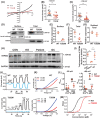Hyperactivation of platelet-derived growth factor signalling contributes to arrhythmogenesis in Brugada syndrome
- PMID: 35184407
- PMCID: PMC8858633
- DOI: 10.1002/ctm2.715
Hyperactivation of platelet-derived growth factor signalling contributes to arrhythmogenesis in Brugada syndrome
Figures




Similar articles
-
Inherited Cardiac Arrhythmia Syndromes: Focus on Molecular Mechanisms Underlying TRPM4 Channelopathies.Cardiovasc Ther. 2020 Dec 16;2020:6615038. doi: 10.1155/2020/6615038. eCollection 2020. Cardiovasc Ther. 2020. PMID: 33381229 Free PMC article. Review.
-
Mutation Load of Multiple Ion Channel Gene Mutations in Brugada Syndrome.Cardiology. 2017;137(4):256-260. doi: 10.1159/000471792. Epub 2017 May 12. Cardiology. 2017. PMID: 28494446
-
TRPM4 mutations to cause autosomal recessive and not autosomal dominant Brugada type 1 syndrome.Eur J Med Genet. 2019 Jun;62(6):103527. doi: 10.1016/j.ejmg.2018.08.008. Epub 2018 Aug 22. Eur J Med Genet. 2019. PMID: 30142439
-
Induced Brugada syndrome: Possible sources of arrhythmogenesis.Rev Port Cardiol. 2017 Dec;36(12):945-956. doi: 10.1016/j.repc.2017.06.015. Epub 2017 Dec 10. Rev Port Cardiol. 2017. PMID: 29233646 Review. English, Portuguese.
-
Effects of mutations and genetic overlap in inherited long-QT and Brugada arrhythmia syndromes.Hellenic J Cardiol. 2012 Nov-Dec;53(6):439-46. Hellenic J Cardiol. 2012. PMID: 23178427 Review. No abstract available.
Cited by
-
Colchicine attenuates the electrical remodeling of post-operative atrial fibrillation through inhibited expression of immune-related hub genes and stabilization of microtubules.Int J Biol Sci. 2023 Jun 4;19(9):2934-2956. doi: 10.7150/ijbs.81961. eCollection 2023. Int J Biol Sci. 2023. PMID: 37324937 Free PMC article.
References
-
- Brugada P, Brugada J. Right bundle branch block, persistent ST segment elevation and sudden cardiac death: a distinct clinical and electrocardiographic syndrome. A multicenter report. J Am Coll Cardiol. 1992;20:1391‐1396. - PubMed
-
- Gualandi F, Zaraket F, Malagu M, et al. Mutation load of multiple ion channel gene mutations in brugada syndrome. Cardiology. 2017;137:256‐260. - PubMed
-
- Janin A, Bessiere F, Georgescu T, Chanavat V, Chevalier P, Millat G. TRPM4 mutations to cause autosomal recessive and not autosomal dominant Brugada type 1 syndrome. Eur J Med Genet. 2019;62:103527. - PubMed
Publication types
MeSH terms
Substances
Grants and funding
LinkOut - more resources
Full Text Sources
